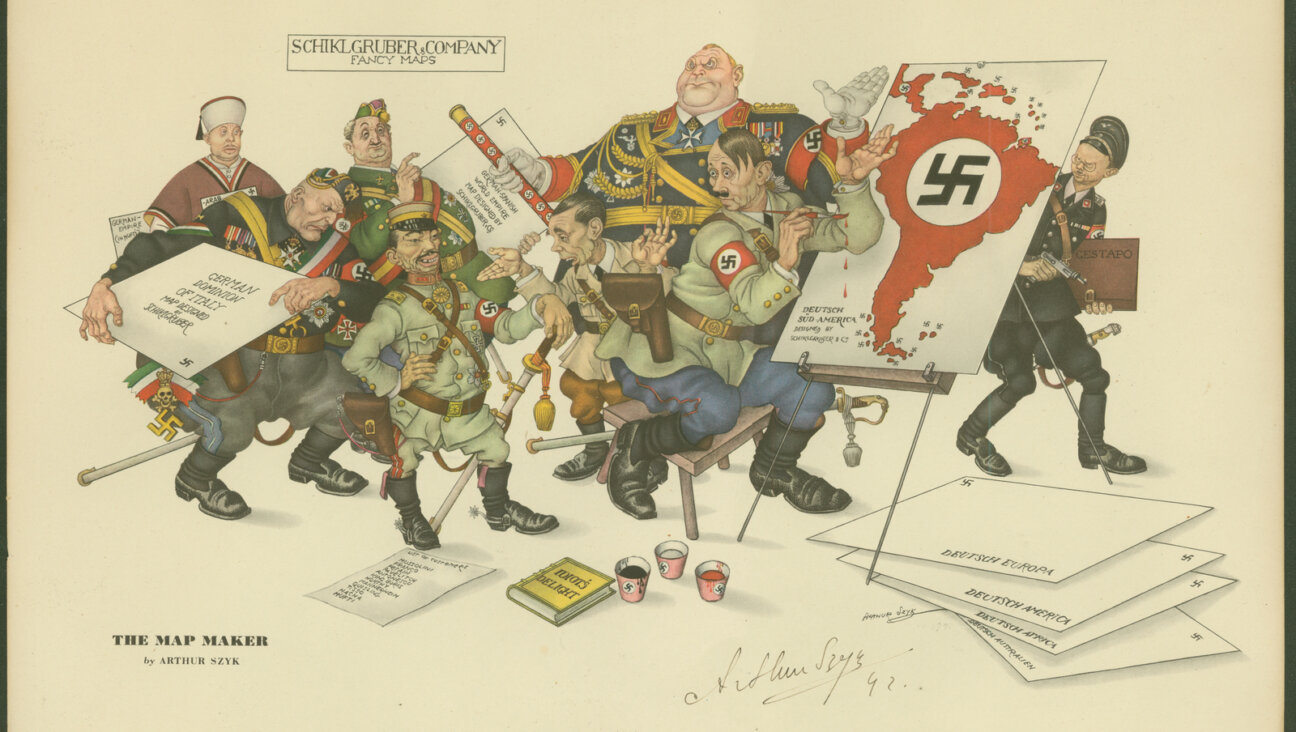Kettle’s On!
Forward reader Mark Hurvitz writes in an e-mail:
“The question of the Yiddish expression hakn a tshaynik [literally, to hit, strike or hack at a teakettle] in the sense of to bother someone came up recently with some friends because Michael Chabon uses a translation of it in his novel ‘The Yiddish Policemen’s Union.’ Why, we wondered, should ‘hitting a teakettle’ mean what it does? I myself am most familiar with this phrase as hak mir nisht kayn tshaynik, i.e., ‘Don’t bother me.’ Does this mean literally, ‘Don’t hit me like a teakettle’? But in that case, who or what is being hit? Or is it that just as a teapot’s lid keeps rattling meaninglessly on a stove, so the person to whom one says hak mir nisht kayn tshaynik is being told, ‘Don’t rattle on at me like the lid of a kettle’? Does that make sense?”
Possibly, although the fact of the matter is that in the past, native Yiddish speakers, too, seemed to find hakn a tshaynik an odd expression whose literal meaning was unclear. It is not even definite that the expression was traditionally used in Eastern Europe, since it may have originated in America. I say this because in Sholom Aleichem’s novel “Motl, Peysi The Cantor’s Son,” there is a scene in which the 10- or 11-year-old Motl, who has immigrated to New York with his family, is talking about a fellow immigrant, a shoemaker named Bereh with a reputation for telling tall tales. Motl remarks:
“Here [that is, in New York], when someone tells such stories, you say that ‘he hits a teakettle’ [er hakt a tshaynik] or that ‘he bluffs’ [er bloft]. I myself like ‘He hits a teakettle’ better. I like it so much that I even put it on paper. That is, I drew Bereh the shoemaker holding a hammer and hitting a teakettle on a table…. Whoever saw my drawing burst out laughing.”
This strongly implies that Motl never encountered the expression before coming to America. Nor, as is obvious from his equation of it with English “to bluff,” did it mean “to bother someone,” as it now increasingly does in American Jewish English. Rather, the original meaning of hakn a tshaynik (which is still adhered to by many speakers) is to exaggerate, to be long-winded or to harangue, so that *hak mir nisht kayn tshaynik *might best be translated as “Don’t talk nonsense” or “Spare me a long speech.”
But what was hakn a tshaynik’s literal meaning? Could it have been what Motl took it to be — and if so, why did it assume the figurative meaning that it did? There seem to be three possibilities:
-
Motl’s interpretation is correct, and hakn a tshaynik meant to strike a kettle with some object, like a spoon or knife, in order to call for the attention of a group of people around a table before making an announcement or giving a speech.
-
Mr. Hurvitz’s interpretation of “Don’t rattle like the lid of a kettle” is the right one. In that case, hakn a tshaynik originally meant not to hit a kettle, but to talk like a kettle. It can be construed in this manner if, in the first place, we take hakn to mean what it does in such Yiddish expressions as hakn in der velt arayn, “to talk to no purpose,” or hakn ligns, “to tell lies,” and secondly, if we parse tshaynik as an adverbial modifier rather than as a direct object. We also are required to assume that hakn meant to talk ramblingly or wildly before the expression hakn a tshaynik came into being rather than as a result of it. Such a development could have taken place under the influence of another Yiddish expression, hakn vi in kroyt, “to spout words,” which means, literally, “to hack as though in [a field of] cabbage,” the comparison being of a person unthinkingly harvesting heads of cabbage to a person unthinkingly running on at the mouth.
-
The suggestion has been made that hakn a tshaynik goes back to the Russian expression udarit’ po chainiku, “to hit [someone] on the teakettle,” chainik or “kettle” in Russian being a colloquial word for the head, like English “noggin” (which once meant a mug or a cup.) Hak mir nisht kayn tshaynik would thus have the literal meaning of “Don’t hit me over the head.”
None of these explanations is entirely satisfactory. The first, while not impossible, seems a bit far-fetched. The second, though one might be able to find a few parallels to it in Yiddish, is grammatically irregular. The third would make sense if “Don’t bother me” were indeed the original meaning of hak mir nisht kayn tshaynik, but is less plausible if it isn’t. It would also oblige us to translate hak mir nisht kayn tshaynik (literally, “Don’t hit me a kettle”) as “Don’t hit my kettle,” treating the dative mir or “me” as a possessive form like “my” (the dative of Yiddish pronouns can function in this manner) rather than as the referential pronoun meaning “in my presence” (that is, “Don’t hit the kettle when I’m around ”) as most Yiddish speakers, I think, would intuitively regard it.
In short, you can take your pick. Mr. Hurvitz’ s choice is as good as any. Any way you look at it, hocking a tshaynik is still hocking a tshaynik.
Questions for Philologos can be sent to [email protected].















